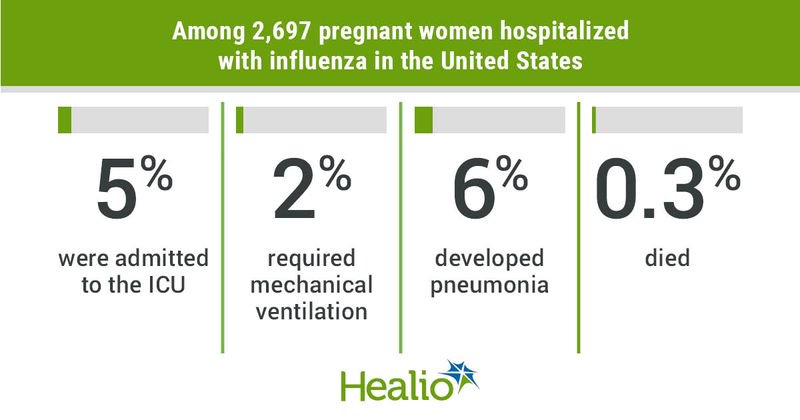Up to one-third of women hospitalized with influenza are pregnant
Click Here to Manage Email Alerts
Up to a third of women hospitalized with influenza in recent years were pregnant, according to research presented at this year’s virtual IDWeek.
“Pregnant women are known to be at increased risk for influenza-associated hospitalization,” Rachel Holstein, MPH, an epidemiology and information science fellow at the CDC, said during the presentation. “However, the data are mixed on whether pregnancy is a risk factor for severe outcomes such as ICU admission, basic mechanical ventilation, complications like pneumonia and death.”

Additionally, Holstein said, information on outcomes of pregnant women hospitalized during influenza seasons following the 2009 H1N1 pandemic is lacking.
Holstein and colleagues evaluated women aged 15 to 44 years who lived in an area within the U.S. Influenza Hospitalization Surveillance Network (FluSurv-NET) and were hospitalized between October 1 and April 30 from 2010 to 2019 with laboratory-confirmed influenza. They collected clinical data on these women using medical charts.
Of the 9,652 women hospitalized with influenza who were identified during the study period, 28% (n = 2,697) were pregnant. The prevalence of pregnant women ranged from 24% to 33.9% during the evaluated influenza seasons, Holstein and colleagues found. The median age was 28 years, with a median gestational age of 32 weeks.
Among pregnant women, 68% had cough and 66% had fever. In addition, 35% had underlying medical conditions: 22.7% had asthma and 7.6% had a chronic metabolic disease. Twelve percent of pregnant women were current smokers.
The researchers determined that just 31% of pregnant women were vaccinated for influenza and 89% had received antivirals.
During hospitalization — which was a medial length of 2 days — 5% of pregnant women were admitted to the ICU, 2% required mechanical ventilation, 6% had pneumonia and 0.3% died.
Upon hospital discharge, 70% of women were still pregnant, 28% were no longer pregnant, and the pregnancy status was unknown for 2% of women, according to the researchers.
Of those women who were no longer pregnant at discharge, 96% had live births, 3% had pregnancies with loss of the fetus or neonate and 1% had unknown outcomes.
“Severe outcomes among pregnant women were infrequent relative to the proportion in the overall FluSurv-NET population,” Holstein said. “However, they were more common in symptomatic pregnant women compared to asymptomatic pregnant women.”
Holstein added that the low rate of vaccination observed among hospitalized pregnant women provides evidence that “opportunities remain to increase annual vaccination coverage among pregnant women in all trimesters of pregnancy.”

